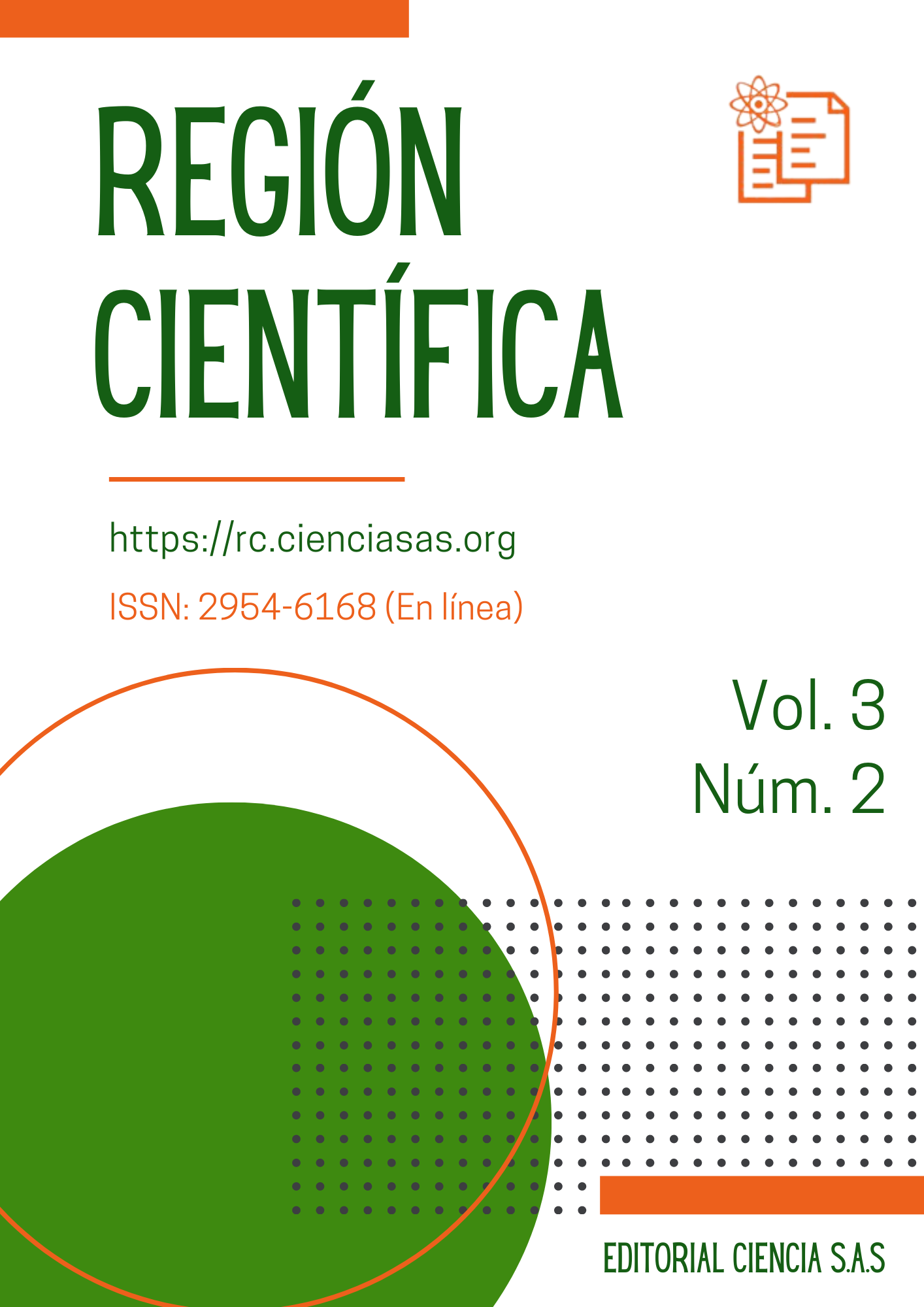Implementation of circular economy in supply chain management: a bibliometric analysis
DOI:
https://doi.org/10.58763/rc2024315Keywords:
bibliometric analysis, circular economy, reverse logistics, supply chainAbstract
Supply chains have a high environmental impact; while the circular economy generates sustainable benefits through the reuse of resources, in this sense, circular supply chains integrate the sustainability of supply chains. The objective is to analyze the implementation of circular economy in supply chain management during the period 2021 - 2023. The research is of a descriptive quantitative type, based on a bibliometric analysis, it was developed in the Scopus database and only research articles found in open access in the areas of engineering, business, management and accounting sciences were taken into account. A total of 293 research papers were identified, the largest number of papers were published in 2022 with 114. The most representative author was Kazancoglu with eight publications. The institution that contributed the most articles was Yaşar Universitesi with 10 researches. The country that published the most was United Kingdom with 76 researches. The researches were published in 83 scientific journals, the most published was Journal of Cleaner Production (n=39), and in turn the most cited with 1138 citations, the one with the highest impact in Scopus was International Journal of Production Economics (IF=11,849)
Metrics
References
Aceved, J. (2008). Modelos y estrategias de desarrollo de la Logística y las Redes de Valor en el entorno de Cuba y Latinoamérica [Tesis e grado]. Instituto Superior Politécnico José Antonio Echeverría.
Acevedo, A. (2013). Modelo de Gestión Colaborativa del Flujo Logístico. [Tesis de grado]. Instituto Superior Politécnico “José Antonio Echeverría”. https://www.researchgate.net/publication/313853777_Modelo_de_Gestion_Colaborativa_del_Flujo_Logistico
Adabre, M., Chan, A., Darko, A., y Hosseini, M. (2023). Facilitating a transition to a circular economy in construction projects: intermediate theoretical models based on the theory of planned behaviour. Building Research and Information, 51(1), 85-104. https://doi.org/10.1080/09613218.2022.2067111
Aguilar, O., Posada, R., y Soto, M. (2012). El otro lado de la logística, una visión estratégica: tendencias del aprovisionamiento en las cadenas de valor para el desarrollo sostenible. Revista del Centro de Investigación. Universidad La Distrito Federal, México: Salle, 10(30), 221-232. https://www.redalyc.org/articulo.oa?id=34224543015
Allen, S., Zhu, Q., y Sarkis, J. (2021). Expanding conceptual boundaries of the sustainable supply chain management and circular economy nexus. Cleaner Logistics and Supply Chain, 2, 100011. https://doi.org/10.1016/j.clscn.2021.100011
Almeida-Guzmán, M., y Díaz-Guevara, C. (2020). Economía circular, una estrategia para el desarrollo sostenible. Avances en Ecuador. Estudios de la Gestión, 8(8), 1-22. https://doi.org/10.32719/25506641.2020.8.10
Aviso, K., Baquillas, J., Chiu, A., … y Tan, R. (2023). Optimizing plastics recycling networks. Cleaner Engineering and Technology, 14, https://doi.org/10.1016/j.clet.2023.100632
Chopra, S., y Meindl, P. (2008). Administración de la cadena de suministro. Estrategia, planeación y operación. Pearson Educación.
De Felice, F., y Polimeni, A. (2020). Coronavirus Disease (COVID-19): A Machine Learning Bibliometric Analysis. In Vivo, 34(3), 1613-1617. https://doi.org/10.21873/invivo.11951
de Mattos, D., de Oliveira-Dias, D., Moyano-Fuentes, J., Maqueira, J., y Garza-Reyes, J. (2023). Interrelationships between circular economy and Industry 4.0: A research agenda for sustainable supply chains. Business Strategy and the Environment. https://doi.org/10.1002/bse.3502
Dextre-Vilchez, S., Febres-Ramos, R., y Mercado-Rey, M. (2023). Análisis bibliométrico de los 100 artículos más citados en Scopus sobre educación médica y COVID-19. Revista Cubana de Información en Ciencias de la Salud, 34, e2196. https://acimed.sld.cu/index.php/acimed/article/view/2196
Dragomir, V., y Dumitru, M. (2022). Practical solutions for circular business models in the fashion industry. Cleaner Logistics and Supply Chain, 4. https://doi.org/10.1016/j.clscn.2022.100040
ElHawary, H., Salimi, A., Diab, N., y Smith, L. (2020). Bibliometric Analysis of Early COVID-19 Research: The Top 50 Cited Papers. Infect Dis (Auckl), 13, 1178633720962935. https://doi.org/10.1177/1178633720962935
Fadeeva, Z., y Van Berkel, R. (2021). Unlocking circular economy for prevention of marine plastic pollution: An exploration of G20 policy and initiatives. Journal of Environmental Management, 277. https://doi.org/10.1016/j.jenvman.2020.111457
Fernando, Y., Tseng, M., Nur, G., Ikhsan, R., y Lim, M. (2023). Practising circular economy performance in Malaysia: managing supply chain disruption and technological innovation capability under industry 4.0. International Journal of Logistics Research and Applications, 26(12), 1704-1727. https://doi.org/10.1080/13675567.2022.2107188
García, S. (2018). Economía circular: 30 años del principio de desarrollo sostenible evolucionan en el nuevo gran objetivo medioambiental de la Unión Europea. Revista de Estudios Europeos, 71, 1-12. https://dialnet.unirioja.es/servlet/articulo?codigo=6347885
Geissdoerfer, M., Morioka, S., Monteirode, M., y Evans, S. (2019). Business models and supply chains for the circular economy. Journal of Cleaner Production, 190(20), 712-721. https://plu.mx/a/?ebscoclient=s5126813&doi=10.1016/j.jclepro.2018.04.159
Geywitz, S. (2020). Economía Circular. Implantación en Ingeniería, Fabricación y Diseño Industrial. Cuad Cent Estud Diseñ Comun, Ensayos, 87. https://dx.doi.org/10.18682/cdc.vi87.3772
Gunaratne, T., Krook, J., y Andersson, H. (2022). Market prospects of secondary construction aggregates in Sweden. Journal of Cleaner Production, 360, 132155. https://doi.org/10.1016/j.jclepro.2022.132155
Haber, N., y Fargnoli, M. (2022). Product-Service Systems for Circular Supply Chain Management: A Functional Approach. Sustainability, 14(22), 14953. https://doi.org/10.3390/su142214953
Helbach, J., Hoffmann, F., Pieper, D., y Allers, K. (2023). Reporting according to the preferred reporting items for systematic reviews and meta-analyses for abstracts (PRISMA-A) depends on abstract length. Journal of Clinical Epidemiology, 154, 167-177. https://doi.org/10.1016/j.jclinepi.2022.12.019
Jaffe, K., Ter Horst, E., Gunn, L., Zambrano, J., y Molina, G. (2020). A network analysis of research productivity by country, discipline, and wealth. Plos one, 15(5), e0232458. https://doi.org/10.1371/journal.pone.0232458
Kamaraj, A., Kyriacou, H., Seah, K., y Khan, W. (2021). Use of human induced pluripotent stem cells for cartilage regeneration in vitro and within chondral defect models of knee joint cartilage in vivo: a Preferred Reporting Items for Systematic Reviews and Meta-Analyses systematic literature review. Cytotherapy, 23(8), 647-661. https://doi.org/10.1016/j.jcyt.2021.03.008
Kazancoglu, I., Sagnak, M., Kumar, S., y Kazancoglu, Y. (2021). Circular economy and the policy: A framework for improving the corporate environmental management in supply chains. Business Strategy and the Environment, 30(1), 590-608. https://doi.org/10.1002/bse.2641
Kotronoulas, G., y Papadopoulou, C. (2023). A Primer to Experimental and Nonexperimental Quantitative Research: The Example Case of Tobacco-Related Mouth Cancer. Seminars in Oncology Nursing, 39(2), 151396. https://doi.org/10.1016/j.soncn.2023.151396
Kumar, M., Raut, R., Jagtap, S., y Choubey, V. (2023). Circular economy adoption challenges in the food supply chain for sustainable development. Business Strategy and the Environment, 32(4), 1334-1356. https://doi.org/10.1002/bse.3191
Liu, L., Song, W., y Liu, Y. (2023). Leveraging digital capabilities toward a circular economy: Reinforcing sustainable supply chain management with Industry 4.0 technologies. Computers and Industrial Engineering, 178, 109113. https://doi.org/10.1016/j.cie.2023.109113
Luu, T., Chromjaková, F., y Nguyen, H. (2023). A model of industry 4.0 and a circular economy for green logistics and a sustainable supply chain. Business Strategy and Development. https://doi.org/10.1002/bsd2.286
Marqués, M. (2013). Modelo y procedimientos para la planificación de medicamentos y materiales de uso médico en instituciones hospitalarias del territorio matancero. [Tesis de grado]. Universidad de Matanzas “Camilo Cienfuegos”.
McDougall, N., Wagner, B., y MacBryde, J. (2022). Competitive benefits & incentivisation at internal, supply chain & societal level circular operations in UK agri-food SMEs. Journal of Business Research, 144, 1149-1162. https://doi.org/10.1016/j.jbusres.2022.02.060
Mehmood, A., Ahmed, S., Viza, E., Bogush, A., y Ayyub, R. (2021). Drivers and barriers towards circular economy in agri-food supply chain: A review. Business Strategy and Development, 4(4), 465-481. https://doi.org/10.1002/bsd2.171
Muñoz-Estrada, G., Chumpitaz, H., Barja-Ore, J., … y Mayta-Tovalino, F. (2022). Análisis bibliométrico de la producción científica mundial sobre el aula invertida en la educación médica. Educación Médica, 23(5), 100758. https://doi.org/10.1016/j.edumed.2022.100758
Nanayakkara, P., Jayalath, M., Thibbotuwawa, A., y Perera, H. (2022). A circular reverse logistics framework for handling e-commerce returns. Cleaner Logistics and Supply Chain, 5, 100080. https://doi.org/10.1016/j.clscn.2022.100080
Okorie, O., Russell, J., Jin, Y.,… y Charnley, F. (2022). Removing barriers to Blockchain use in circular food supply chains: Practitioner views on achieving operational effectiveness. Cleaner Logistics and Supply Chain, 5, 100087. https://doi.org/10.1016/j.clscn.2022.100087
Pericàs, J., Arenas, A., Torrallardona-Murphy, O., Valero, H., y Nicolás, D. (2020). Published evidence on COVID-19 in top-ranked journals: a descriptive study. European journal of internal medicine, 79, 120-122. https://doi.org/10.1016/j.ejim.2020.07.005
Prieto, V., Jaca, C., y Ormazabal, M. (2017). Economía circular: Relación con la evolución del concepto de sostenibilidad y estrategias para su implementación. Memoria Investigaciones en Ingeniería, 15, 1-10. https://dialnet.unirioja.es/servlet/articulo?codigo=6296083
Rasool, F., Greco, M., Morales-Alonso, G., y Carrasco-Gallego, R. (2023). What is next? The effect of reverse logistics adoption on digitalization and inter-organizational collaboration. International Journal of Physical Distribution and Logistics Management, 53(5-6), 563-588. https://doi.org/10.1108/IJPDLM-06-2022-0173
Ridaura, G. (2020). La Economía Circular en Ecuador: Perspectivas de Cumplimiento de los ODS en la Era Post COVID-19. CienciAmérica, 9(4), 1-9. https://doi.org/10.33210/ca.v9i4.339
Rodríguez-Espíndola, O., Cuevas-Romo, A., Chowdhury, … y Dey, P. (2022). The role of circular economy principles and sustainable-oriented innovation to enhance social, economic and environmental performance: Evidence from Mexican SMEs. International Journal of Production Economics, 248, 108495. https://doi.org/10.1016/j.ijpe.2022.108495
Romagnoli, S., Tarabu, C., Maleki, B., y De Giovanni, P. (2023). The Impact of Digital Technologies and Sustainable Practices on Circular Supply Chain Management. Logistics, 7(1), 1. https://doi.org/10.3390/logistics7010001
Ruggerio, C. (2021). Sustainability and sustainable development: A review of principles and definitions. Science of the Total Environment, 786. https://doi.org/10.1016/j.scitotenv.2021.147481
Sánchez, Y., Pérez, J., Sangroni, N., Cruz, C., y Medina, Y. (2021). Retos actuales de la logística y la cadena de suministro. Ingeniería Industrial, XLII(1), 1-12. https://dialnet.unirioja.es/servlet/articulo?codigo=7907251
Schultz, F., Everding, S., y Pies, I. (2021). Circular supply chain governance: A qualitative-empirical study of the European polyurethane industry to facilitate functional circular supply chain management. Journal of Cleaner Production, 317, 128445. https://doi.org/10.1016/j.jclepro.2021.128445
Silobrit, I., y Jureviciene, D. (2023). Assessing Circular Textile Industry Development. Economics and Culture, 20(1), 55-67. https://doi.org/10.2478/jec-2023-0005
Upadhyay, A., Mukhuty, S., Kumar, V., y Kazancoglu, Y. (2021). Blockchain technology and the circular economy: Implications for sustainability and social responsibility. Journal of Cleaner Production, 293, 126130. https://doi.org/10.1016/j.jclepro.2021.126130
Viscardi, S., Colicchia, C., y Creazza, A. (2022). Circular economy and food waste in supply chains: a literature review. International Journal of Logistics Research and Applications. https://doi.org/10.1080/13675567.2022.2128095
Wójcik-Karpacz, A., Karpacz, J., Brzeziński, P., Pietruszka-Ortyl, A., y Ziębicki, B. (2023). Barriers and Drivers for Changes in Circular Business Models in a Textile Recycling Sector: Results of Qualitative Empirical Research. Energies, 16(1), 490. https://doi.org/10.3390/en16010490
Yu, W., Zhou, L., Shi, Z., … y Chen, S. (2023). Hematoma enlargement after intracerebral hemorrhage: a bibliometric analysis. World Neurosurgery. https://doi.org/10.1016/j.wneu.2023.10.117
Zarbakhshnia, N., Govindan, K., Kannan, D., y Goh, M. (2023). Outsourcing logistics operations in circular economy towards to sustainable development goals. Business Strategy and the Environment, 32(1), 134-162. https://doi.org/10.1002/bse.3122
Zhang, A., Wang, J., Farooque, M., Wang, Y., y Choi, T. (2021). Multi-dimensional circular supply chain management: A comparative review of the state-of-the-art practices and research. Transportation Research Part E: Logistics and Transportation Review, 155, 102509. https://doi.org/10.1016/j.tre.2021.102509
Zhang, Y., Wang, Y., y Yadav, B. (2022). Application of Circular Economy and Uncertainty Planning in Analyzing the Sustainable Closed-Loop Supply Chain Network Design. Mathematical Problems in Engineering, 2022, 5320974. https://doi.org/10.1155/2022/5320974
Downloads
Published
How to Cite
Issue
Section
License
Copyright (c) 2024 Sonia Emilia Leyva Ricardo, José Armando Pancorbo Sandoval

This work is licensed under a Creative Commons Attribution-NonCommercial-ShareAlike 4.0 International License.
Este artículo se distribuye bajo la licencia Creative CommonsReconocimiento-NoComercial-CompartirIgual 4.0 Internacional. A menos que se indique lo contrario, el material publicado asociado se distribuye bajo la misma licencia.












